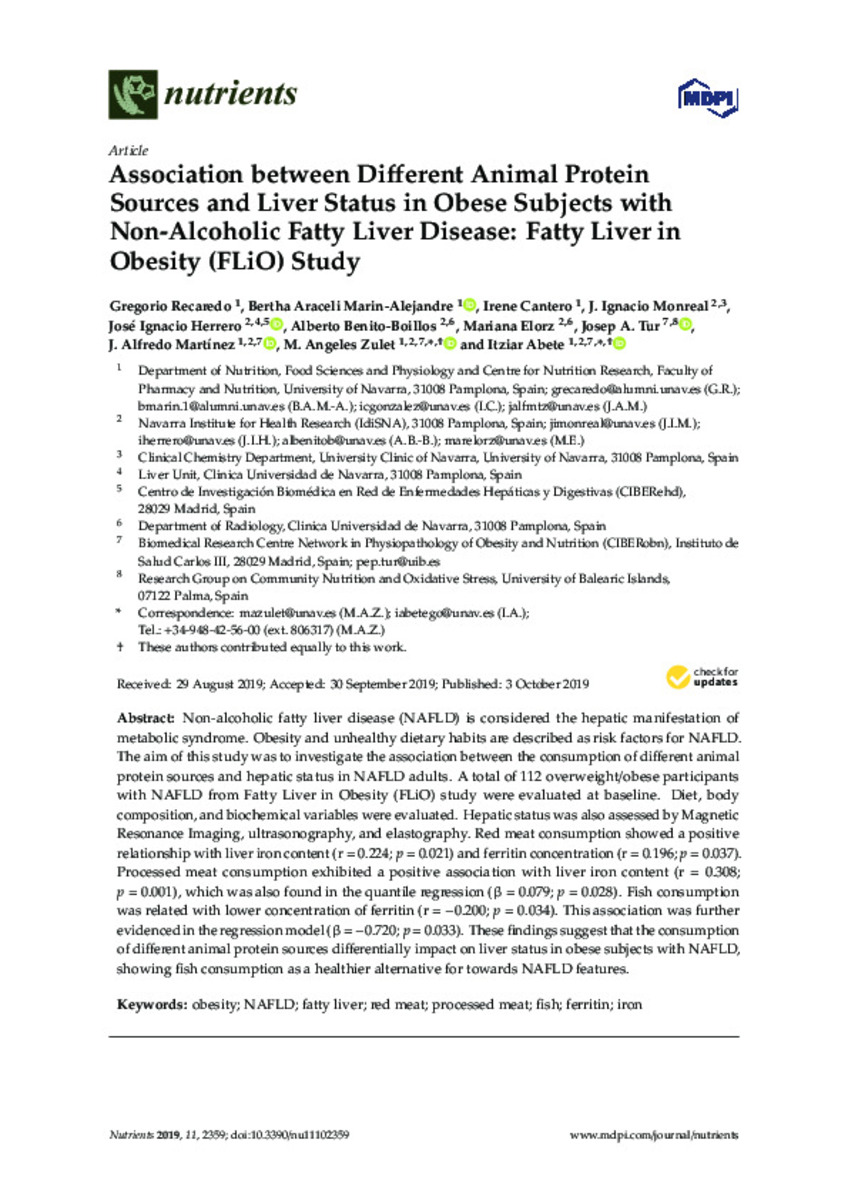Full metadata record
| DC Field | Value | Language |
|---|---|---|
| dc.creator | Recaredo, G. (Gregorio) | - |
| dc.creator | Marin-Alejandre, B.A. (Bertha Araceli) | - |
| dc.creator | Cantero-González, I. (Irene) | - |
| dc.creator | Monreal, J.I. (José Ignacio) | - |
| dc.creator | Herrero, J.I. (José Ignacio) | - |
| dc.creator | Benito-Boíllos, A. (Alberto) | - |
| dc.creator | Elorz, M. (Mariana) | - |
| dc.creator | Tur, J.A. (Josep A.) | - |
| dc.creator | Martinez, A. (Alfredo) | - |
| dc.creator | Zulet, M.A. (María Ángeles) | - |
| dc.creator | Abete, I. (Itziar) | - |
| dc.date.accessioned | 2021-09-23T09:56:31Z | - |
| dc.date.available | 2021-09-23T09:56:31Z | - |
| dc.date.issued | 2019 | - |
| dc.identifier.citation | Recaredo, G. (Gregorio); Marin-Alejandre, B.A. (Bertha Araceli); Cantero-González, I. (Irene); et al. "Association between Different Animal Protein Sources and Liver Status in Obese Subjects with Non-Alcoholic Fatty Liver Disease: Fatty Liver in Obesity (FLiO) Study". Nutrients. 11 (2359), 2019, 1 - 11 | es |
| dc.identifier.issn | 2072-6643 | - |
| dc.identifier.other | PMID: 31623368 | - |
| dc.identifier.uri | https://hdl.handle.net/10171/62060 | - |
| dc.description.abstract | Non-alcoholic fatty liver disease (NAFLD) is considered the hepatic manifestation of metabolic syndrome. Obesity and unhealthy dietary habits are described as risk factors for NAFLD. The aim of this study was to investigate the association between the consumption of different animal protein sources and hepatic status in NAFLD adults. A total of 112 overweight/obese participants with NAFLD from Fatty Liver in Obesity (FLiO) study were evaluated at baseline. Diet, body composition, and biochemical variables were evaluated. Hepatic status was also assessed by Magnetic Resonance Imaging, ultrasonography, and elastography. Red meat consumption showed a positive relationship with liver iron content (r = 0.224; p = 0.021) and ferritin concentration (r = 0.196; p = 0.037). Processed meat consumption exhibited a positive association with liver iron content (r = 0.308; p = 0.001), which was also found in the quantile regression (β = 0.079; p = 0.028). Fish consumption was related with lower concentration of ferritin (r = -0.200; p = 0.034). This association was further evidenced in the regression model (β = -0.720; p = 0.033). These findings suggest that the consumption of different animal protein sources differentially impact on liver status in obese subjects with NAFLD, showing fish consumption as a healthier alternative for towards NAFLD features. | es_ES |
| dc.description.sponsorship | The FLiO study was funded by the Health Department of the Government of Navarra (61/2015), CIBERobn (Physiopathology of Obesity and Nutrition) (CB12/03/3002) and Fundació La Marató de TV3 (201630.10). | es_ES |
| dc.language.iso | eng | es_ES |
| dc.publisher | MDPI AG | es_ES |
| dc.rights | info:eu-repo/semantics/openAccess | es_ES |
| dc.subject | Materias Investigacion::Ciencias de la Salud::Nutrición y dietética | es_ES |
| dc.subject | NAFLD | es_ES |
| dc.subject | Fatty liver | es_ES |
| dc.subject | Ferritin | es_ES |
| dc.subject | Fish | es_ES |
| dc.subject | Iron | es_ES |
| dc.subject | Obesity | es_ES |
| dc.subject | Processed meat | es_ES |
| dc.subject | Red meat | es_ES |
| dc.title | Association between Different Animal Protein Sources and Liver Status in Obese Subjects with Non-Alcoholic Fatty Liver Disease: Fatty Liver in Obesity (FLiO) Study | es_ES |
| dc.type | info:eu-repo/semantics/article | es_ES |
| dc.description.note | This article is an open access article distributed under the terms and conditions of the Creative Commons Attribution (CC BY) license (http://creativecommons.org/licenses/by/4.0/). | es_ES |
| dc.identifier.doi | 10.3390/nu11102359 | - |
| dadun.citation.endingPage | 11 | es_ES |
| dadun.citation.number | 2359 | es_ES |
| dadun.citation.publicationName | Nutrients | es_ES |
| dadun.citation.startingPage | 1 | es_ES |
| dadun.citation.volume | 11 | es_ES |
Files in This Item:
Statistics and impact
Items in Dadun are protected by copyright, with all rights reserved, unless otherwise indicated.






